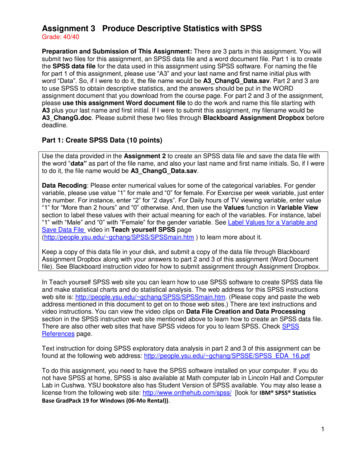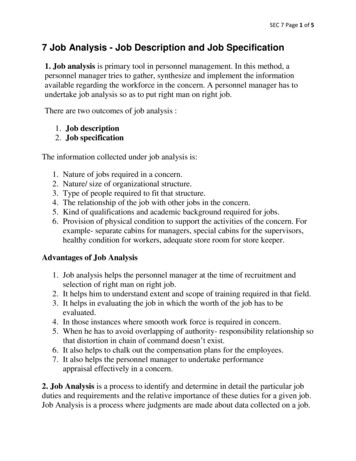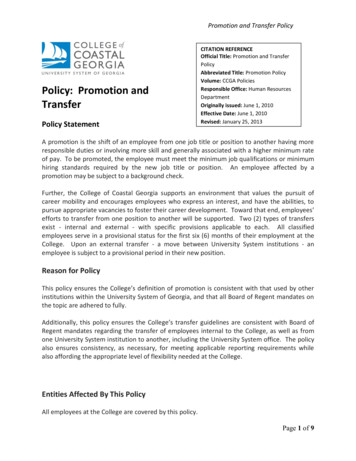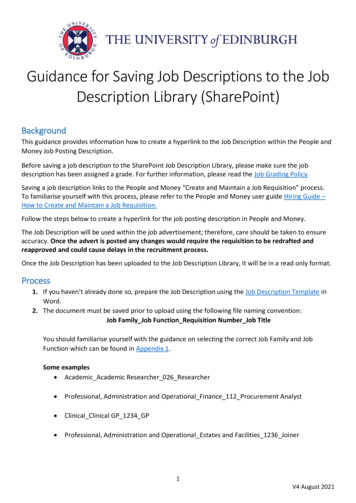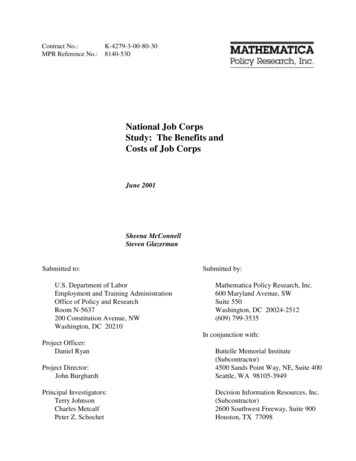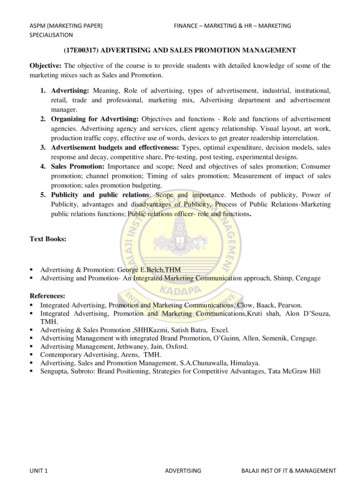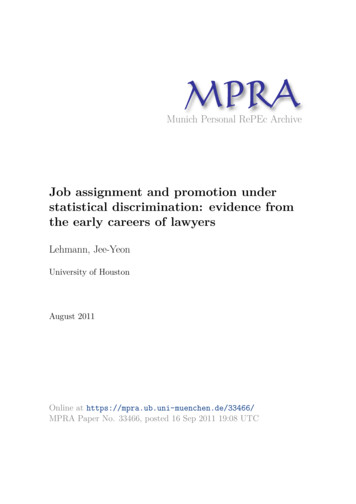
Transcription
Munich Personal RePEc ArchiveJob assignment and promotion understatistical discrimination: evidence fromthe early careers of lawyersLehmann, Jee-YeonUniversity of HoustonAugust 2011Online at https://mpra.ub.uni-muenchen.de/33466/MPRA Paper No. 33466, posted 16 Sep 2011 19:08 UTC
Job Assignment and Promotion Under Statistical Discrimination:Evidence from the Early Careers of Lawyers Jee-Yeon K. Lehmann†University of HoustonAugust 10, 2011AbstractMinorities continue to be severely underrepresented at the top levels of most occupationsdespite making dramatic gains in initial access to them. This fact is particularly striking in thelegal profession where blacks are well represented in each associate class yet face significantlylower probabilities of making partner. To explain this divergence in the career paths of blacksand whites, I develop a dynamic model of statistical discrimination in which firms diversifytheir workforce by lowering the hiring standard for blacks. Despite such a diversity goal athiring, task assignment and promotion decisions are not constrained by this policy. Undersuch institutional setting, the model predicts that although blacks are more likely to be hiredcompared to observably similar whites, they are more likely to be placed in worse tasks and lesslikely to be promoted conditional on the same set of observables. However, conditional on taskassignment, blacks and whites face similar promotion rates.I test the model’s predictions using new data from the After the JD study – a uniquelongitudinal survey tracking the professional lives of more than 4,000 lawyers. Compared towhites of similar credentials, blacks are much more likely to be hired into the best law firms.However, they are assigned to worse tasks and are less likely to be a partner. This black-whitedifference in promotion rates can be explained by quality differences in task assignments earlyin the associates’ careers even controlling for measures of effort and career preferences. Resultsfrom this paper provide a unique explanation for the underrepresentation of minorities at thetop of professional ladders by revealing how incompatible strategies in job assignment can reducethe number of minority promotions compared to the case without affirmative action. I am grateful to Claudia Olivetti, Kevin Lang, and Michael Manove for their encouragement and advice onthis project. Special thanks to Jim Rebitzer, Bob Margo, Andy Newman, Jeremy Smith, Marian Vidal-Fernandez,Gabriele Plickert at the AJD Study, and seminar participants at the various institutions at which I presented thispaper. I am indebted to the legal professionals who have provided me with valuable institutional knowledge. Iacknowledge the Jacob K. Javits Fellowship, the Harvey Fellowship, and the Boston University IED Special ResearchAward for financial support. The views and conclusions stated herein are those of the author and do not necessarilyreflect the views of individuals or organizations associated with the After the JD Study. All remaining errors are myown.†Department of Economics, University of Houston. E-mail: jlehmann@uh.edu1
Job Assignment and Promotion Under Statistical DiscriminationJee-Yeon K. LehmannIn large, national law firms, the most pressing issues have probably shifted from hiringand initial access to problems concerning the terms and conditions of employment,especially promotion to partnership.11IntroductionMinorities continue to be severely underrepresented at the top levels of most occupations despitemaking dramatic gains in initial access to these professions. This large gap between minority hiringand promotion rates is particularly striking in the market for lawyers. In the last three decades,there has been a steady increase in the number of racial minorities entering the legal field. In 1984,racial minorities made up only 8.6 percent of the law school graduating class, but by 2008, theyrepresented twenty-two percent of all J.D. recipients. Coupled with this rising trend in minority lawschool enrollment, large corporate law firms have proactively recruited minority lawyers in responseto public scrutiny regarding staff diversity.2 Consequently, the racial breakdown of associates inlarge law firms is fairly representative of the graduating law school class. Panel A in Table 1 showsthat in 2009, minorities made up close to 20 percent of all associates, with greater proportionsworking in bigger law firms.3 However, as shown in Panel B, the racial composition of partnerstells a dramatically different story with minorities making up only 4.5 to just over 7 percent ofpartners across all firm sizes.4In this paper, I develop a dynamic model of statistical discrimination to understand this gapbetween minority representation at the top and lower levels of the professional ladder. My modelincorporates hiring, task assignment, and promotion in the presence of a firm-wide hiring policythat raises the hiring rates of a minority group (e.g. black). Despite such a diversity goal athiring, task assignment and promotion decisions are not constrained by this policy. Within suchan institutional framework, the model predicts that although blacks are more likely to be hiredthan observably similar whites, blacks are assigned to worse tasks even conditional on the sameset of observables. Since better tasks allow associates to develop skills necessary for promotion1Diversity in Law Firms. (2003). U.S. Equal Employment Opportunity Commission.A number of legal organizations routinely publish “Diversity Score Cards” based on the number of minorityattorneys in major law firms. For example, see Diversity Score Card 2010 published by the American Lawyerat http://www.law.com/jsp/tal/PubArticleTAL.jsp?id 1202444469087 These reports are widely discussed andreferenced by those in the legal field and media.3In 2009, minorities made up just below 22% of all J.D.’s awarded and blacks about 6%.4Cohort effect may be a part of the explanation behind this gap between minority/black representation at theassociate and partner levels. Associates typically reach partnership eligibility after 7 years with the firm, and minoritygains at the associate level takes time to trickle up to the partnership level. However, minority representation amongpartners in 2009 is still well below the percent of minority J.D.s 25 years earlier. Therefore, cohort effect cannot bethe main explanation for the persisting gap between hiring and promotion of minorities.22
Job Assignment and Promotion Under Statistical DiscriminationJee-Yeon K. LehmannTable 1: Racial Demographics of Associates and Partners at U.S. Law Firms in 2009Panel A: AssociatesFirm Size (# of lawyers)50 or fewer51-100101-250251-500501-700701 TotalTotal1,4683,31710,10510,6557,29530,32863,168% All Minorities14.3115.1915.8317.0218.7822.8519.67% Black2.453.324.404.854.694.934.66Panel B: PartnersFirm Size (# of lawyers)50 or fewer51-100101-250251-500501-700701 TotalTotal2,1165,23414,75612,5026,82120,39261,821% All Minorities5.255.814.525.346.357.636.05% Black0.951.151.321.802.022.051.71Source: Women and Minorities in Law Firms by Race and Ethnicity. (January 2010). NALP Bulletin. Retrieved August 23,2010 from http://www.nalp.org/race ethn jan2010.more easily, blacks will be much less likely to become a partner compared to whites with similarcredentials. Yet conditional on the task assignment, blacks and whites should face similar promotionrates. I test the model’s predictions using new data from the After the J.D. Study – a nationallyrepresentative survey of lawyers who entered the bar in year 2000 – and find support for all mypredictions.The motivation for my model’s institutional framework originates from two prevailing explanations in the legal field for the underrepresentation of minorities among partners, especially forblack lawyers. First, in a highly controversial study that has received much public criticism, Sander(2008) argues that in an effort to achieve diversity within the hiring class, elite law firms hire blackswith much lower credentials than whites noting that “Black students, who make up 1 to 2 percent ofstudents with high grades.make up 8 percent of corporate law firm hires.”5 Sander’s assertion thatthe underrepresentation of blacks in partnership is merely a reflection of their lack of qualificationsis a common argument used to explain the scarcity of minorities at the top of other professionalladders.However, most of Sander’s critics suggest that there may be more complex sources of highattrition and low partnership among black lawyers. In particular, they highlight the distinctionbetween an institutional hiring process and partner-directed work assignment and training.5Lawyers Debate Why Blacks Lag at Major Firms. New York Times, November 29, 2006.3
Job Assignment and Promotion Under Statistical DiscriminationJee-Yeon K. LehmannCritics generally concede the raw numbers. But they offer different reasons for the gapbetween hiring and promotion. Some point to old-fashioned racism. Others say thatfirms act institutionally in hiring but leave work assignments to individual partners.Those partners often provide poor training, rote assignments and little mentoring tominority lawyers.6There may be a number of explanations for the presence of firm-wide diversity efforts at hiring.Minorities may improve the firm’s general image and reputation and attract better job applicants.For example, a number of legal organizations routinely publish reports called “diversity score cards”ranking major law firms based on the number of minority attorneys.7 These reports are highly citedby legal publications and frequently referenced by potential clients and job applicants. Furthermore,law schools may be particularly interested in improving the initial placements of their minoritygraduates and may foster close, mutually beneficial ties with law firms who actively recruit andhire minorities. Additionally, if the firm is ultimately concerned with increasing the number ofminorities at the senior level, raising their representation at the junior rank is one simple strategyit can follow.However, task assignment and promotion may not reflect such diversity efforts at hiring for avariety of reasons. First, as suggested by those in the legal profession, firms may act institutionallyin hiring while job assignments are decentralized to individual partners. In large firms, especially, acentral hiring committee of seniors and individuals from the human resources group set recruitingand hiring agendas. To increase the diversity of its hiring class, the firm might choose to increase thenumber of minorities hired by decreasing their hiring standard below that of whites (“affirmativeaction”). Senior/partners know that affirmative action has been used in hiring, and therefore,minority hires are less qualified than members of the majority group on average. Then thesepartners may be more likely to offer rote assignments and little mentoring to minorities. Since thehiring committee cannot fully oversee or dictate the daily interactions between the seniors and thenew hires, it may not be able to counter these tendencies.Second, although law schools are able to monitor the first professional placements of theirgraduates closely, most schools do not track their students throughout their careers. Consequently,school support for minority graduates may be short-lived, and law school ties to law firms are morelikely to be based on the initial hiring of their graduates rather than on the specific conditionsof their employment or career advancements. Third, despite minorities’ value to the firm’s imageand public relations, skills that are seen as important for partnership (e.g. client-building) areoften deemed “culturally white”. This may be due to customer biases or the lack of social/business67Ibid.See Figure A.1 in the Appendix for an example of a diversity score card.4
Job Assignment and Promotion Under Statistical DiscriminationJee-Yeon K. Lehmannnetworks from which minorities can draw potential clients. For any combination of these reasonsand others, task assignments and promotion may reflect the firm’s efforts to diversify its hiringclass.Under this institutional setting, the basic intuition of my theoretical model is as follows. Suppose firms are only able to observe a noisy signal of the job candidate’s qualifications and his/hergroup identity: black or white. Because firms are interested in increasing the number of black hires,they will lower the signal threshold above which they will hire a black candidate below the cut-offfor whites. The partners responsible for task assignments know that there are now more unqualifiedworkers among the black hires and than among the whites hires. Therefore, they will require ahigher signal from the black hires to assign them to the more challenging task (“promotion-track”).Affirmative action, together with a higher standard for promotion track assignment, implies thata greater proportion of the black hires are unqualified and assigned to the non-promotion trackcompared to observably similar whites. Only qualified workers in the promotion track gain the necessary skills for partnership even conditional on observable measures of worker quality. Therefore,promotion rates among the hired blacks will be lower compared to their white peers. However,conditional on being assigned to the promotion track, a similar proportion of blacks and whitesshould be qualified and promoted.In the second half of this paper, I bring the model’s predictions to the After the JD Study (AJD),a new longitudinal survey that tracks the professional lives of over 4,000 lawyers who entered thebar in year 2000. This unique dataset has not been used previously in economic research, partlybecause the second wave has only been released to the public in the summer of 2010. In the AJD, Ifocus on black and white differences and find the following results. One, conditional on observablecredentials (e.g. GPA, law school ranking, law review), black lawyers are 7 to 30 percentage pointsmore likely to be hired at the largest law firms.8 Two, conditional on being hired, blacks aremuch less likely to be formulating strategies with partners or supervising other attorneys, and theyalso face significantly lower promotion rates than whites. Sander’s simple model of affirmativeaction can explain these two predictions about hiring and promotion. Three, even conditional onthese observable skill signals, these black-white differences in task assignments and promotion stillremain. Note that this prediction is not consistent with the simple model of affirmative actionbut is consistent with a model of statistical discrimination. Four, conditional on task assignment,black and white associates have statistically equal promotion rates. These findings are robust tocontrolling for measures of effort and career preferences. Together these results are consistent witha model of affirmative action in the presence of statistical discrimination that leads to worse taskassignment for blacks, but conditional on being assigned to more complex tasks, blacks and whites8These magnitudes vary across GPA-law school tier categories.5
Job Assignment and Promotion Under Statistical DiscriminationJee-Yeon K. Lehmannare similarly qualified. This is the essence of my model.The contributions of this paper are varied. First, I develop a new perspective on discriminationand diversity across job levels by analyzing the consequences of a diversity-seeking institutional hiring process and decentralized task assignment and promotion within a dynamic model of statisticaldiscrimination. Second, to my knowledge, this is the first study that empirically demonstrates theconnection between worse task assignments and lower promotion rates of blacks by taking advantage of a unique dataset containing information about employment conditions and career paths oflawyers.9 Finally, although I frame the main discussion in the context of lawyers, the applicationsof the model and its predictions are not limited to the legal field. This paper contributes to thewider discussion regarding minority underrepresentation at the managerial and executive ranks byrevealing how incompatible strategies in job assignments and promotion can reverse the intendedgoals of diversity programs early in the careers of minorities.2Related Theoretical LiteratureThe theoretical model in this paper builds on the statistical discrimination literature in which firmsuse observable characteristics (e.g. race, sex) that are correlated with worker productivity whenthey only have noisy information about the job applicant’s true qualifications. If group A’s meanproductivity is lower on average than group B’s and the productivity signal is equally informativefor both groups, Phelps (1972) shows that the expected productivity conditional on the signal willbe lower for group A.10The basic structure of my model is most closely related to Coate and Loury (1993) and Fryer(2007). The former considers the effect of affirmative action on the employer’s negative stereotypesby building upon Arrow’s (1972) earlier work. In their model, employer’s lower ex-ante evaluationsof minority workers’ qualifications result in their being assigned to the skilled-job less frequently fora given level of investment. This negative stereotype results in the minority group facing a lowerreturn to human capital investment, and in equilibrium, generates self-confirming stereotypes. Thecentral part of Coate and Loury’s model is the introduction of affirmative action that requiresthe same rate of assignment to the skilled-job for the two groups. Under such a policy, thereare equilibria in which affirmative action moves the economy to a state of homogeneous beliefs,but there is also a “patronizing equilibrium” in which the anti-discrimination policy lowers thestandard for the minority group, decreasing the return to human capital investment, and widening9Most empirical studies examining the shortage of minorities at the top of the professional ladder have focused ongender differences rather than racial differences. For example, see Winter-Ebmer and Zweimuller (1997), McDowell,Singell, and Ziliak (1999), and Blau and DeVaro (2007).10For a detailed summary of the statistical discrimination literature, see Fang and Moro’s (2010) review.6
Job Assignment and Promotion Under Statistical DiscriminationJee-Yeon K. Lehmannthe ex-post differences in productivity.In one of the first explicitly dynamic models of statistical discrimination, Fryer (2007) incorporates aspects of Coate and Loury (2003) in developing a two-stage job assignment game to assessthe impact of negative stereotypes at the time of the worker’s labor market entry on the evolutionof his career. In the paper, Fryer focuses on developing sufficient conditions for “belief-flipping” toarise in a dynamic equilibrium in which one group is subjected to negative stereotypes in the hiringstage, but once hired, the successful members of that group are more likely to be promoted.My model differs from Fryer (2007) in the following ways. In Fryer, blacks are discriminatedagainst early in their career, but if the conditions for “belief-flipping” are met, they face higherpromotion rates. However, the opposite pattern holds true in many occupations, including lawfirms. Furthermore, whether conditions for belief-flipping hold or not, Fryer’s model cannot accountfor the higher hiring rates for blacks that we observe in the market for lawyers. In my model, Iintroduce a unique institutional framework in which firms abide by a diversity program at hiringyet task assignment and promotion decisions are entirely profit-driven. Under such a setup, blacksface higher hiring rates yet have lower chances for promotion even conditional on observables.Finally, the empirical objective of this paper is most closely related to Bjerk (2008). In hismodel, Bjerk shows that if worker groups differ in their average skill level and/or the precision orthe frequency of their skill signals prior to entering the labor market, equally skilled workers fromdifferent groups will have varying likelihood of making it to the top jobs. The intuition behindBjerk’s result is as follows. Suppose workers have one of two skill levels (high or low) and threejob levels (low, career, and director) into which the workers can be hired or promoted. Low-skillworkers are most productive at the lowest job and least productive at the director level. Theopposite is true for the high-skill worker. Firms do not directly observe the worker’s skill level,but update their initial beliefs about the workers by observing the track record of each workerat his job or signals that each worker can emit before the labor market or at the low job level.Under these assumptions, firms set two critical levels of belief thresholds for hiring or promotingthe worker into the two highest job levels. If group the fraction of skilled worker in A is lower thanB or if firms acquire information about B more rapidly than A, then it will take individuals fromA longer to be hired or promoted to the higher job levels than equally skilled members of groupB. Therefore, individuals in A will be underrepresented in these jobs relative to their proportionamong the highly skilled.As with Fryer, although we can explain the underrepresentation of the less skilled group at thetop using Bjerk’s model, we cannot account for their higher hiring rates. A hiring policy that forcesfirms to over-hire from the less skilled group is necessary to explain why blacks might face lowerhiring standards than whites as we observe in the AJD.7
Job Assignment and Promotion Under Statistical Discrimination3Jee-Yeon K. LehmannA Dynamic Model of Job Assignment and Promotion UnderStatistical DiscriminationIn this section, I introduce a dynamic model of statistical discrimination in the presence of a policythat raises the hiring rates of blacks above that of whites – a policy that I refer to as “affirmativeaction”. In the setup, I adopt much of the language and notations of Coate and Loury (1993) andFryer (2007) for ease of comparison and interpretation.The basic sequence of events is as follows:1. Nature chooses the applicant’s group j {B, W } and his type t {qualified(q), unqualified(u)}.2. The firm sees a noisy signal φ [0, 1] of the applicant’s type and chooses to lower the signalhiring standard for group B below that of W .3. Each partner sees a noisy signal θ [0, 1] of the hired worker’s type and places the workerinto one of two tracks.4. Worker invests towards promotion.5. Workers’ type are revealed and only qualified workers who invested are promoted. All otherworkers are let go.3.1Formal Model Setup3.1.1HiringConsider a large number of identical firms and a large population of workers belonging to one oftwo groups j {B, W }. For each worker i, nature assigns his group membership and his typet {qualified(q), unqualified(u)}. The fraction of qualified workers in the population π is the samefor both B and W . Firms are randomly matched with many workers. For each worker i, the firmalso observes his group identity j and a noisy signal of his type φ [0, 1].Let Hq (φ) and Hu (φ) be the distribution of φ for a qualified and an unqualified worker, respectively. The associated density functions are hq (φ) and hu (φ). Assume that Hq (φ) Hu (φ) for allφ. Therefore, higher values of the signal are more likely if the worker is qualified, and for a givenprior, the posterior likelihood that a worker is qualified is larger if his signal takes a higher value.The central hiring committee wants to diversify their workforce by increasing the representationHof B in their hiring class. It achieves this by lowering the signal hiring standard sHB sW , choosingto hire the worker from group j if and only if his signal φ is greater than or equal to sHj .8
Job Assignment and Promotion Under Statistical Discrimination3.1.2Jee-Yeon K. LehmannAssignment into Promotion Track versus Non-promotion TrackThe interpretation of the track assignment can be rather broad. For example, the two tracks canbe distinguished by quality differences in the tasks associated with them. The promotion track ischaracterized by more demanding and rewarding task assignments while the non-promotion trackis defined by rote tasks and unchallenging/unsatisfying work. We can also interpret the trackassignment as the decision whether to mentor and prepare the worker for promotion or not. Inreality, the two tracks are probably differentiated by a combination of quality differences in bothtasks and mentoring. The important criterion for our analysis is that the firm’s benefit (cost) fromassigning a qualified (unqualified) worker to the promotion track is higher than the non-promotiontrack.After the worker is hired, he/she is matched with a senior or partner who observes a signalθ [0, 1] of the worker’s type. θ is distributed according to Fq (θ) and Fu (θ) with associated densityfunctions fq (θ) and fu (θ). We define a likelihood ratio ϕ(θ) fu (θ)/fq (θ) and assume that it isstrictly decreasing in θ. Similar to φ, this implies that Fq (θ) Fu (θ) for all θ. Based on θ and theworker’s group membership, the firm decides whether to place him/her in the promotion track orthe non-promotion track.In both tracks, I assume that employers earn a positive return from the worker only if the workeris qualified. Otherwise, all workers would be hired. Wages are determined exogenously, and theworker receives a gross benefit of w regardless of his track assignment. This assumption on wagesmakes particular sense in the context of large corporate law firms where financial compensation forassociates is determined in a lockstep fashion with each associate class receiving the same salaryand bonuses each year they are with the firm. Furthermore, as long as one’s track assignment isnot fully verifiable to the worker and to the outside firms, wages conditional on track assignmentsshould be non-contractable. For example, suppose workers demand higher wages in the promotiontrack. Then firms have an incentive to lie about the assignment as long the worker cannot tellclearly which track he is in. On the other hand, if some workers are willing to take lower wagesto be in the promotion track, then for workers with low enough signals, firms have an incentive toplace them in the non-promotion track while claiming they are on the promotion track. Therefore,if the quality differences between the two tracks are subtle enough, wages cannot be credibly tiedto task assignments.In theory, qualified workers may be able to additionally signal their type by working longerhours. However, in my data, both black and white lawyers work long hours, and their hours arenot statistically different. This is consistent with Landers, Rebitzer, and Taylor (1996) in which thelaw firm’s reliance upon work hours as an indicator of the associate’s quality leads to a “rat-race”9
Job Assignment and Promotion Under Statistical DiscriminationJee-Yeon K. LehmannTable 2: Firm Net Payoff by Track Assignment and Worker xNqUnqualified xPu xNuequilibrium in which all lawyers overwork early in their careers.Table 2 describes the firm’s net return from a worker of a given type across the two taskNPassignments. The relation among the payoffs can be summarized as xPq xNq 0 xu xu .In other words, while the firm’s benefit from correctly assigning a qualified worker to the promotiontrack is greater than the non-promotion track, the cost of an unqualified worker is also higher inthe promotion track.3.1.3PromotionOnce hired, the worker decides whether to invest toward promotion or not. The cost of his effortsdepends on the task to which he is assigned. I assume that the investment cost in the promotiontrack (cP ) is lower than in the non-promotion track (cN ). One can interpret these investment costsas the cost of any additional effort required beyond regular duties (whether in intensity or scope)that one must put in to prove himself to be promotion-worthy. cP is lower than cN , because tasks inthe promotion track garner more recognition from seniors and/or active mentoring provide betterpreparation for partnership.Before the promotion decision, workers’ types are revealed, and only qualified workers whoinvested for partnership are promoted. All unqualified workers and qualified workers who did notinvest towards promotion are let go. If the worker is promoted, he receives a gross payoff of W wand the firm gains a net payoff of X xPq . Qualified workers who are not promoted receive woutside the firm, and unqualified worker’s outside earning is normalized to zero. The final payoffto each agent is the sum of the payoffs in each period with no discounting.3.23.2.1Strategies & EquilibriaWorker Investment Towards PromotionLet’s start with the worker’s investment decision for promotion. He will work toward promotion ifonly if his cost of investment is less than or equal to his expected gain from promotion. I assumethat an unqualified worker’s cost is sufficiently high such that he will never invest for promotion.10
Job Assignment and Promotion Under Statistical DiscriminationJee-Yeon K. LehmannA qualified worker will invest if and only if his cost is less than or equal to W w. In the analysisbelow, I assume that it is only optimal for the qualified, promotion-track workers to invest towardspromotion.Assumption 1. Only qualified, promotion-track workers invest towards promotion:cP W w c N .(1)This assumption streamlines our definition of strategies and equilibria by allowing us to definetwo standards for a given π and set of payoffs rather than four. At the end of the theoretical section,I describe the equilibria when qualified workers in both tracks invest toward promotion. R
Table 1: Racial Demographics of Associates and Partners at U.S. Law Firms in 2009 Panel A: Associates Firm Size (# of lawyers) Total % All Minorities % Black Panel B: Partners Firm Size (# of lawyers) Total % All Minorities % Black Source: Women and Minorities in Law Firms by Race and Ethnicity. (January 2010). NALP Bulletin. Retrieved August 23,
